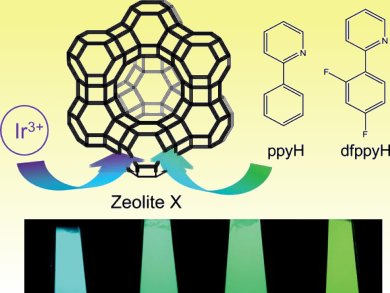Host–guest systems are created by introducing molecules into cavities in suitable materials. The stabilizing, protective effect of the host and certain interactions between the host framework and the guest molecule confer unique properties to such systems. Host–guest systems are useful as optical materials, catalysts, adsorbents, and sensors in various applications.
Yuji Wada, Tokyo Institute of Technology, Japan, and co-workers prepared ortho-metalated luminescent iridium(III) complexes in the supercages of faujasite-type zeolites by a microwave-assisted ship-in-a-bottle procedure. First, the IrIII ions were introduced into the supercages by ion exchange. Then, two different ligands were added to form complexes. The size of the cavities prevented the complexes from exiting the cages. As a result, different complexes with different amounts of the two ligands, having different emission wavelengths, were trapped in different supercages.
The researchers were thus able to tune the color of the light emitted from these systems in a range from blue to green.
Image: © Wiley-VCH
- Luminescence of ortho-Metalated Iridium Complexes Encapsulated in Zeolite Supercages by the Ship-in-a-Bottle Method,
C. Xu, D. Mochizuki, Y. Hashimoto, T. Honda, Y. Tsukahara, T. Yamauchi, Y. Wada,
Eur. J. Inorg. Chem. 2012.
DOI: 10.1002/ejic.201200116




